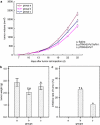Antitumor effect of sFlt-1 gene therapy system mediated by Bifidobacterium Infantis on Lewis lung cancer in mice
- PMID: 21921942
- PMCID: PMC3215997
- DOI: 10.1038/cgt.2011.57
Antitumor effect of sFlt-1 gene therapy system mediated by Bifidobacterium Infantis on Lewis lung cancer in mice
Abstract
Soluble fms-like tyrosine kinase receptor (sFlt-1) is a soluble form of extramembrane part of vascular endothelial growth factor receptor-1 (VEGFR-1) that has antitumor effects. Bifidobacterium Infantis is a kind of non-pathogenic and anaerobic bacteria that may have specific targeting property of hypoxic environment inside of solid tumors. The aim of this study was to construct Bifidobacterium Infantis-mediated sFlt-1 gene transferring system and investigate its antitumor effect on Lewis lung cancer (LLC) in mice. Our results demonstrated that the Bifidobacterium Infantis-mediated sFlt-1 gene transferring system was constructed successfully and the system could express sFlt-1 at the levels of gene and protein. This system could not only significantly inhibit growth of human umbilical vein endothelial cells induced by VEGF in vitro, but also inhibit the tumor growth and prolong survival time of LLC C57BL/6 mice safely. These data suggest that Bifidobacterium Infantis-mediated sFlt-1 gene transferring system presents a promising therapeutic approach for the treatment of cancer.
Figures









Similar articles
-
Inhibitory effect of Bifidobacterium infantis-mediated sKDR prokaryotic expression system on angiogenesis and growth of Lewis lung cancer in mice.BMC Cancer. 2012 Apr 26;12:155. doi: 10.1186/1471-2407-12-155. BMC Cancer. 2012. PMID: 22536942 Free PMC article.
-
[Construction and expression of soluble vascular endothelial growth factor receptor-1 eukaryotic expression vector and its effect on proliferation of vascular endothelial cells].Sheng Wu Yi Xue Gong Cheng Xue Za Zhi. 2010 Apr;27(2):369-72. Sheng Wu Yi Xue Gong Cheng Xue Za Zhi. 2010. PMID: 20481321 Chinese.
-
Soluble Flt-1 gene delivery in acute myeloid leukemic cells mediating a nonviral gene carrier.Biomed Res Int. 2013;2013:752603. doi: 10.1155/2013/752603. Epub 2013 Jan 10. Biomed Res Int. 2013. PMID: 23509773 Free PMC article.
-
Soluble Fms-like tyrosine kinase-1 expression inhibits the growth of multiple myeloma in nude mice.Acta Biochim Biophys Sin (Shanghai). 2007 Jul;39(7):499-506. doi: 10.1111/j.1745-7270.2007.00310.x. Acta Biochim Biophys Sin (Shanghai). 2007. PMID: 17622469
-
[Cloning and prokaryotic expression of Bifidobacterium infantis-mediated sKDR and its effect on proliferation of vascular endothelial cells].Sichuan Da Xue Xue Bao Yi Xue Ban. 2009 Sep;40(5):784-6, 802. Sichuan Da Xue Xue Bao Yi Xue Ban. 2009. PMID: 19950583 Chinese.
Cited by
-
Bacteria-driven hypoxia targeting delivery of chemotherapeutic drug proving outcome of breast cancer.J Nanobiotechnology. 2022 Apr 2;20(1):178. doi: 10.1186/s12951-022-01373-1. J Nanobiotechnology. 2022. PMID: 35366890 Free PMC article.
-
Bifidobacterium infantis-Mediated Herpes Simplex Virus-TK/Ganciclovir Treatment Inhibits Cancer Metastasis in Mouse Model.Int J Mol Sci. 2023 Jul 21;24(14):11721. doi: 10.3390/ijms241411721. Int J Mol Sci. 2023. PMID: 37511481 Free PMC article.
-
Antitumor mechanisms of bifidobacteria.Oncol Lett. 2018 Jul;16(1):3-8. doi: 10.3892/ol.2018.8692. Epub 2018 May 10. Oncol Lett. 2018. PMID: 29963126 Free PMC article. Review.
-
Engineered Bacteria for Disease Diagnosis and Treatment Using Synthetic Biology.Microb Biotechnol. 2025 Jan;18(1):e70080. doi: 10.1111/1751-7915.70080. Microb Biotechnol. 2025. PMID: 39801378 Free PMC article. Review.
-
Gut Microbiota: the Emerging Link to Lung Homeostasis and Disease.J Bacteriol. 2021 Jan 25;203(4):e00454-20. doi: 10.1128/JB.00454-20. Print 2021 Jan 25. J Bacteriol. 2021. PMID: 33077630 Free PMC article. Review.
References
-
- Sonmezer M, Gungor M, Ensari A, Ortac F. Prognostic significance of tumor angiogenesis in epithelial ovarian cancer: in association with transforming growth factor [beta] and vascular endothelial growth factor. Int J Gynecol Cancer. 2004;14:82–88. - PubMed
-
- Li W, Xu RJ, Zhang HH, Jiang LH. Overexpression of cyclooxygenase-2 correlates with tumor angiogenesis in endometrial carcinoma. Int J Gynecol Cancer. 2006;16:1673–1678. - PubMed
-
- Cantu De Leon D, Lopez-Graniel C, Mendivil MF, Vilchis GC, Gomez C, Salazar JDLG. Significance of microvascular density (MVD) in cervical cancer recurrence. Int J Gynecol Cancer. 2003;13:856–862. - PubMed
-
- Chen WT, Huang CJ, Wu MT, Yang SF, Su YC, Chai CY. Hypoxia-inducible factor-1[alpha] is associated with risk of aggressive behavior and tumor angiogenesis in gastrointestinal stromal tumor. Jpn J Clin Oncol. 2005;35:207–213. - PubMed
-
- Joo YEMD, Rew JSMD, Seo YHMD, Choi SKMD, Kim YJMD, Park CSMD, et al. Cyclooxygenase-2 overexpression correlates with vascular endothelial growth factor expression and tumor angiogenesis in gastric cancer. J Clin Gastroenterol. 2003;37:28–33. - PubMed
Publication types
MeSH terms
Substances
LinkOut - more resources
Full Text Sources
Medical
Miscellaneous

